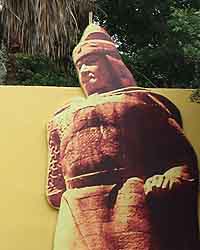|
 |
|
CALM SEAS: Sea goddess Mazu is widely worshipped in China's southeast coastal areas, especially in Fujian and Taiwan (WU SHI) |
On the afternoon of May 15, a ship carrying 350 worshippers of sea goddess Mazu from Taiwan's Taichung Port arrived at Fujian Province's Meizhou Island passenger port. It was the first direct passage between the two points. A grand ceremony, attended by Fujian's Vice Provincial Governor Li Chuan and local officials, was held on the island. They welcomed the believers who traveled across the Taiwan Straits to make a pilgrimage to Mazu Temple on Meizhou Island, which is the hometown of the goddess.
On the morning of May 16, more than 2,000 Taiwanese Mazu believers met for a massive pilgrimage ceremony at the temple's Shengzhimen Square. By holding the ceremony, the Mazu worshippers also hoped to win support for the application to label the Mazu belief as a significant piece of intangible cultural heritage by the United Nations Educational, Scientific and Cultural Organization. Many believers signed their names on the application.
After the pilgrimage ended, 600 Taiwanese Mazu followers participated in the opening ceremony of the Straits Forum in Fujian's Xiamen.
The vast majority of Taiwan residents trace their family's history to Fujian, which sits on opposite sides of the Taiwan Straits. Early immigrants brought their culture, customs and way of life to Taiwan, which are preserved to today. Fujian shares more in common with Taiwan than any other mainland province.
Of the many cultural bonds, the common belief in Mazu between the two provinces proves to be one of the strongest. Around two thirds of Taiwanese are Mazu believers.
About Mazu
The legend of Mazu, a Goddess of the Sea, is about a girl named Lin Mo who became a goddess. Lin was born in 960 on Meizhou Island, a small piece of land in the Taiwan Straits off the coast of southeast China. The girl's mother conceived Lin because she ate a flower blossom given to her in a dream by Guanyin, the goddess of mercy.
Lin was a remarkably intelligent girl. Thanks to her vast knowledge of Chinese medicine, she was able to cure the sick and teach people how to prevent illness and injury. Lin was also able to predict the weather. Many of the miracles she performed involved quelling storms at sea, so she became known as the protector of seafarers.
Lin was a master of both Buddhism and Taoism. Her death at the age of 28 on a mountaintop allowed her to become a goddess. It is said that she was carried into heaven in a golden pillar of light.
Many mariner folktales have been created about averted catastrophes when the Goddess Mazu, dressed in red, appeared to sailors as a warning that unseen storms were arising and thus their voyages should be postponed.
Nowadays, Mazu is widely worshipped in the southeastern coastal areas of China like Fujian, Taiwan, Guangdong and Zhejiang, as well as neighboring areas in Southeast Asia.
Zheng Chenggong Cultural Festival
 |
|
Sculpture of Zheng Chenggong (YANG JIA) | On the afternoon of May 17, more than 1,000 people from both sides of the Taiwan Straits gathered on the island of Gulangyu in Xiamen's Siming District for the grand opening ceremony of the Zheng Chenggong Cultural Festival.
Zheng, a Ming Dynasty (1368-1644) general who lived from 1624 to 1662, led 25,000 soldiers in several hundred warships from Xiamen, Fujian Province, to Taiwan, which had been occupied by Dutch colonialists. After several months of fierce fighting, they removed the Dutch from Taiwan and ended the 38-year colonial occupation.
Zheng made great efforts to develop Taiwan and laid a foundation for its important position as an economic and trade center in the ensuing centuries. Zheng has been depicted for many years as a saint and the protector of the island. Temples have been dedicated to him all over Taiwan, where Zheng died shortly after his victory over the Dutch.
The Zheng Chenggong Cultural Festival has been held in Taiwan's Tainan City for eight years. Meanwhile, Zheng-related cultural heritage can be found everywhere in Xiamen.
Zheng named Siming District, the center of his army training, in memory of the then collapsing Ming Dynasty. It was to highlight the common history between Fujian and Taiwan that the cultural festival was held there during the first Cross-Straits Forum. It was also an occasion for people to commemorate Zheng as a common national hero of all Chinese. There was also a groundbreaking ceremony for the new Zheng ancestral temple, a traditional folk art show featuring work from the two provinces and the Zheng cultural forum.
| 